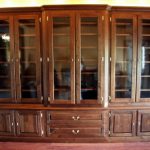We may receive a commission when you use our affiliate links. However, this does not impact our recommendations.

When we think of drawers, we invariably think of drawers like those found in our kitchens. You yank on the pull, they slide out effortlessly, then a bump from the hip has them shut. Such drawers provide quick access to oft used items.
No traditional drawer you or I make will function like these. And I have my doubts they were ever designed to. Period drawers simply don’t fit their cases with “piston” like tolerances. Most probably drooped disconcertingly when half open.
Its entirely possible our whole conception of the function of a drawer is different than those members of the 18th c. Oft needed items were likely placed on shelves or hung from hooks. Instead of ready storage, chests of drawers may have been thought of as holders of boxes. Drawers may have been removed entirely for access. When you think of highboys whose top drawers were well above eye level or the items typically stored in chests of drawers (textiles), the removal of drawers for access begins to make more sense, than having the thing hang open and expecting it to go back into place with ease.
Adam
Here are some supplies and tools we find essential in our everyday work around the shop. We may receive a commission from sales referred by our links; however, we have carefully selected these products for their usefulness and quality.









In making Windsor chairs I have been experiencing an increase in requests to have me restore furniture. No,I do not do the strip and paint stuff done to flea market junk or fine 18th century pieces. It’s the family heirloom furniture piece that is about a hundred years descending from a special family member known by the present owner. I usually have to use hand tools to make peices that must be replaced since it allows me the freedom to make the new piece fit the character of the rest. I often think of the addage that says "better is the enemy of good" that I feel must have played in the minds of 19th century craftsmen. Symmetrical conversion in our brains from bi-nocular vision, is too powerful a natural part of us to see many of these imperfections. This came to me earlier in a shocking revelation.
Reproducing a 1770 Lancaster County, PA sack-back chair for a local museum’s fund raising gala was a wake up call. I made a seat template, very hard to do from an actual chair since the spindles are in the way. I crafted the seat for the new chair in my shop and brought it up into the kitchen to admire before retiring for the night. I sat it on our colorful counter and turned the lights off. The next morning was a shock. The seat was very asymmetrical as the left side front curve towards the back sie was significantly different from the right. The contrast between the counter color and the clean wood profile helped make it jump out at me. Oh my goodness did I not have the drawknife and spokeshave skills to work better than that? I double checked my template and it showed the same effect. So as soon as I could I returned to the museum to double check the original and to my surpise it too was made that way. I had reproduced the old chairmaker’s anomaly. Subsequently I have studied several other sack-backs made by this same "un-named" chairmaker and they too all show the same problem. He must have made a seat pattern that had this anomaly in it and continued using it over and over again, never seeing the defect. When one looks at the original chairs, it’s nearly impossible to see this defect without doing crazy stuff with our eyes since our brain processes both sides with images from each eye, averaging the images it receives and makes it look perfect. Symmetry in the brain is more powerful than the work of the craftsman.
Sometimes we learn things the hard (long) way, and other times we learn the right way the first time out. Such is the case on my soon to be completed first case piece with seven drawers. A few months ago you may recall, I posted on woodcentral a question regarding drawer fronts with lips; I actually used a lot of those suggestions from that post from people like Warren and yourself. It certainly is encouraging for folks who truly use "hand tools only" knowing that 18c drawers didn’t fit with piston-like precision. Now I do pay attention to good technique when building drawers and for a good fit to adjust with wood movement, but I certainly didn’t get caught in the trap of attempting to make my drawers like kitchen cabinet drawers. Your article in PopWood this month was most timely….just wish they would give you double the space to write more. I am just not sure I would be a subscriber if you didn’t write articles.
Best regards,
Roderick